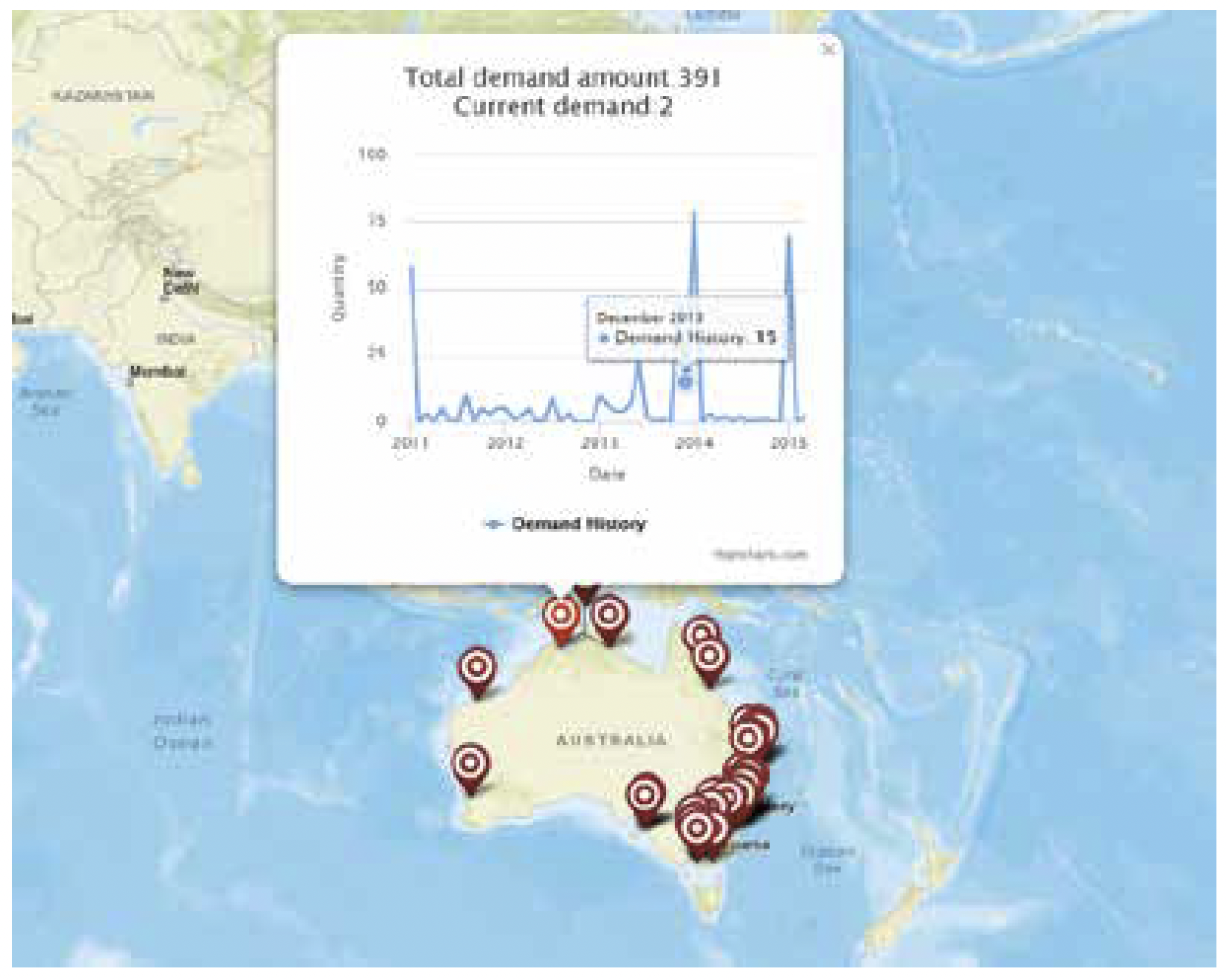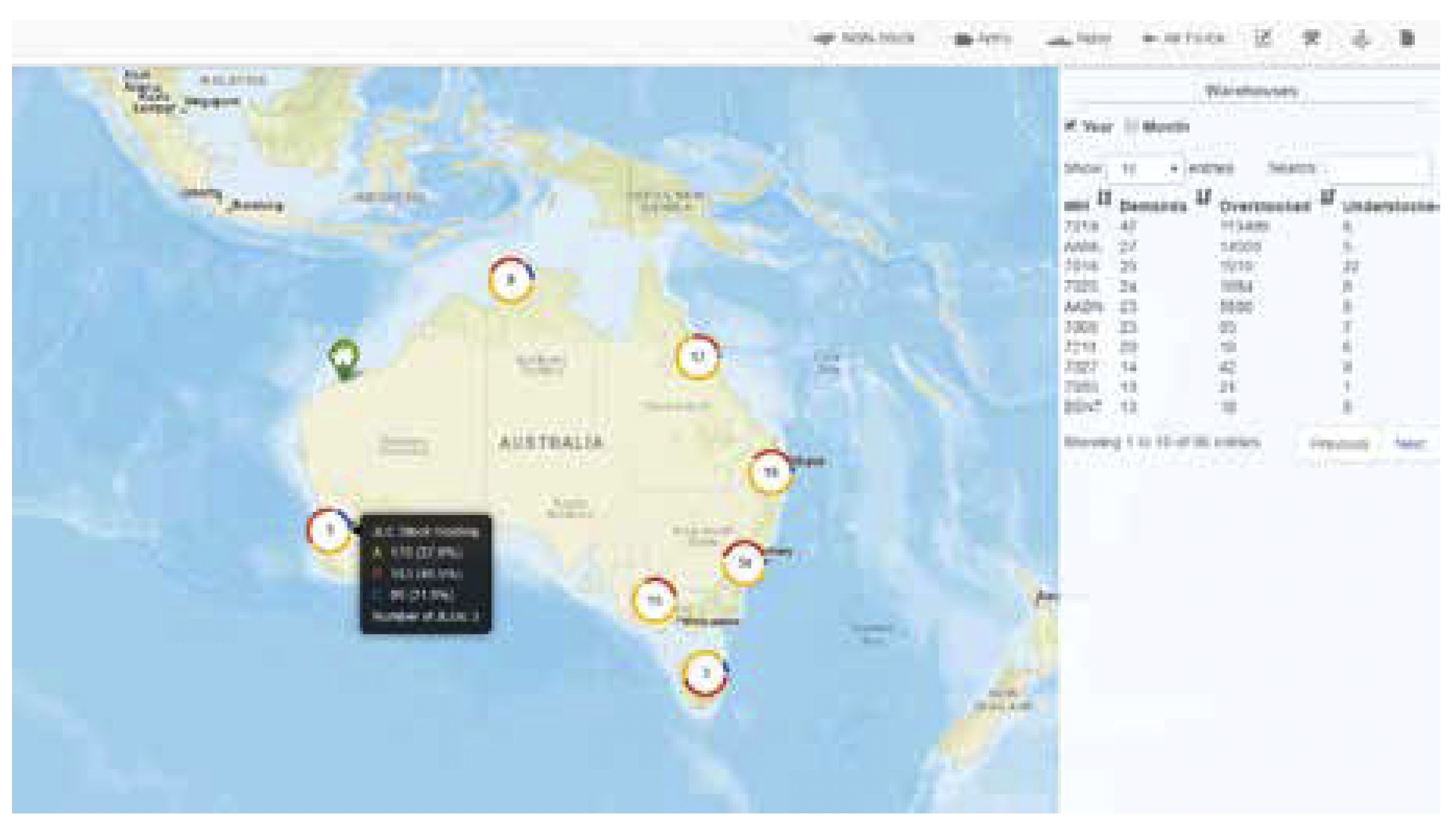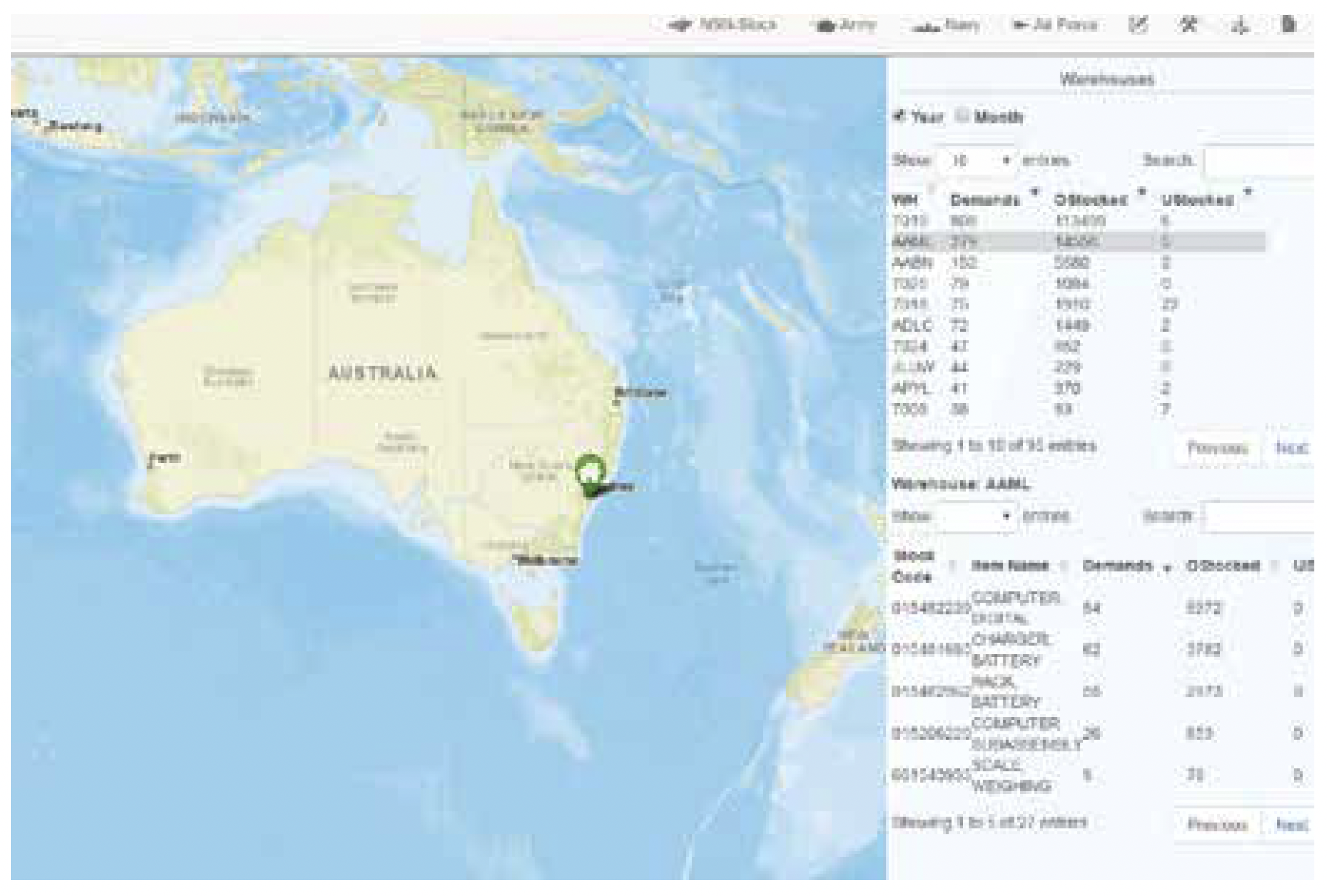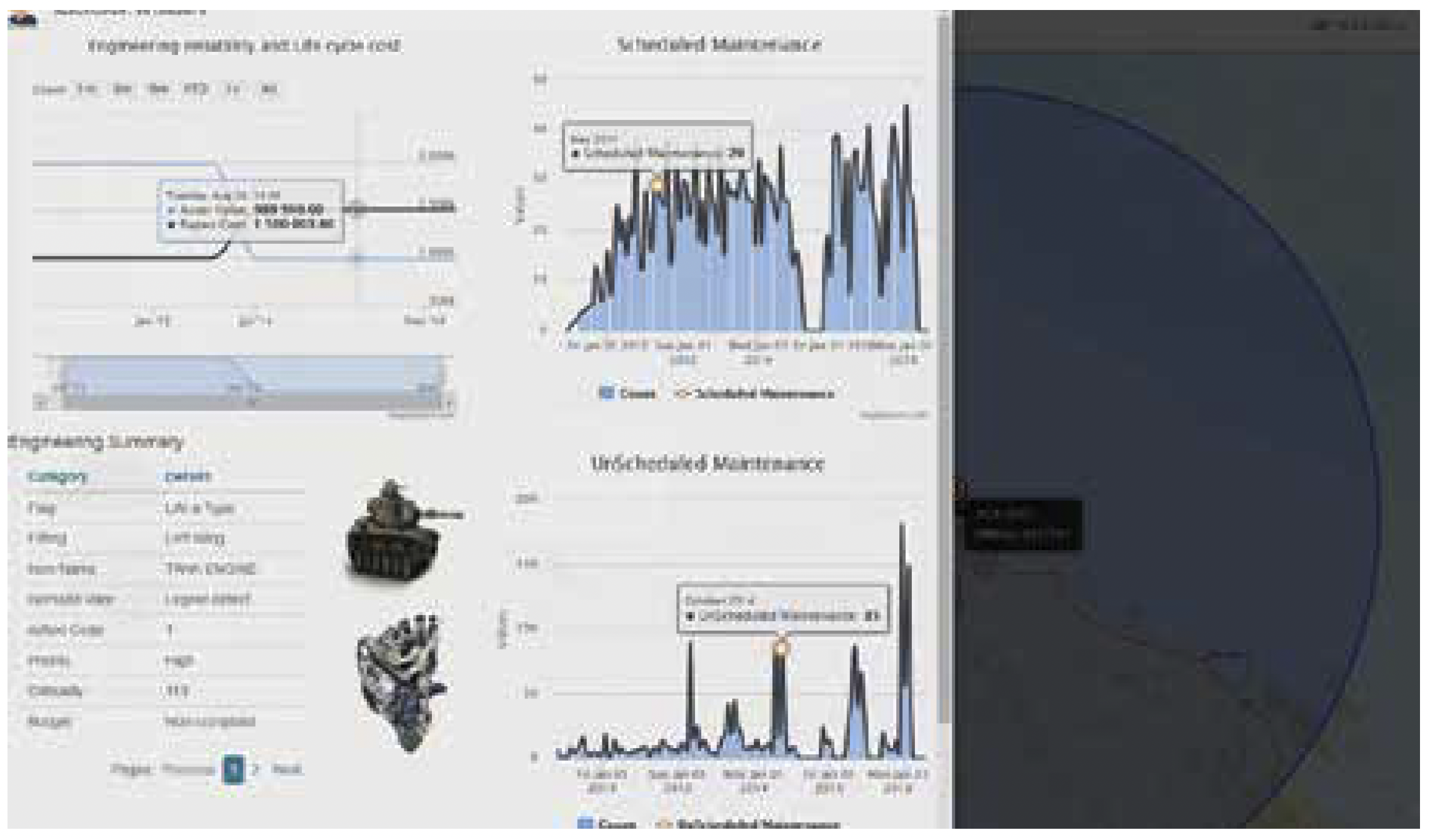Abstract
‘Sua Tela Tonanti’ is the motto of the Royal Australian Army Ordnance Corps (RAAOC), which is translated as ‘To the Warrior his Arms’. This task has increased in difficulty over time. The growing sophistication of Army platforms, the higher tempo of Army operations, and the high diversity of Army operational locations has greatly complicated the task of bringing the warrior their arms. Thus, Army logisticians currently face considerable difficulties in decision-making. These primarily stem from the need to access, utilise and maintain information from a large number of databases. This has led to considerable data inaccuracy, data incompleteness and significant lags in report generation leading to a significant impact on Army logistics management efforts. To address this issue, we suggest there is scope for a systems-based solution. In this paper, we describe a current prototype that: harnesses current data sources; 2) overcomes current data limitations; and 3) results in a centralized and seamless user experience. We further suggest that the underpinning ideas behind the prototype could be an effective means to overcome the current issues facing Army logisticians, particularly as this relates to report generation, inventory management decisions and forecasting. The approach represented by the prototype also allows Army to use current resources rather than replace them completely.
-
Introduction
- ‘The line between order and disorder lies in logistics…’ Sun Tzu, the Art of War (circa 500 BC).
-
The importance of logistics to military operations has long been recognised. Classic military writers such as Sun Tzu and Carl von Clausewitz were well aware of the need for adequate supplies. The level of access to appropriate materiel can ultimately determine an army’s ability to fulfil its mission. Weaknesses in military logistics can also expose the army to hazardous situations and ultimately lead to its destruction. The modern army is even more dependent on robust logistics capabilities. However, military logistics has now evolved considerably; a point not lost on the Australian Army. In recent times, the Australian Army has conducted peacekeeping, humanitarian and disaster relief operations, with these now forming the kernel of Defence activities more broadly described in the First Principles Review 2016. In addition, the Australian Army must maintain operational readiness, so it also conducts training and other activities in this regard.
These greater demands pose a series of challenges for Army logisticians. First, Army platforms have increased in diversity and sophistication. For example, a new platform design could reduce the effectiveness of a current logistics monitoring system if operators are unsure how to record platform characteristics in a given database. Second, Army continues to face a high operational tempo. This creates high usage situations for Army platforms, thus increasing the need for maintenance and for materiel supplies including fuels and oils. Third, the global footprint of Army operations creates long distances between warehouses or storage facilities and the location of use. Again, this places greater pressure on Army logistics operations through higher maintenance and materiel supplies.
The higher pressure on Army logistics operations has highlighted the limitations of current management approaches. Army currently utilises multiple logistics databases which are mostly isolated from one another. The need to enter data multiple times in conditions where Army logisticians are under considerable time pressure has inevitably led to poor data quality in many respects. For reporting purposes, this data is often inadequate and can force platform managers to access multiple databases for simple reporting purposes. Considerable scope exists therefore to reconsider the approach Army takes to logistics management.
The First Principles Review 2016 advocates a ‘One Defence’ approach. This intention has subsequently been reflected in the Defence Industry Policy Statement as well as in Defence planning more broadly. A major tenet of this is the centralisation of the management approach to Defence operations. For Army, this has multiple impacts, some of which relate to the ways in which Army manages logistics. However, there has been limited discussion as to what this means in a forum such as this journal. The purpose of this paper, therefore, is to describe how an Information Technology (IT) could provide a mechanism to centralise and streamline Army logistics management. The paper begins with an elaboration on the issues currently facing Army logistics. Next, we argue that a robust business intelligence platform could support an Army logistics management approach that aligns with the One Defence notion, while also improving the Army logistics management capability. Lastly, we present a prototype of a system that attempts to achieve this. We conclude by offering a series of reflections on our suggested approach for Army.
Current Problems Facing Army Logisticians
Army logisticians currently face a range of challenges, many of which date back more than 20 year1-3. In synthesizing multiple sources, three major issues appear to account for the majority of these challenges:
- Planning and forecasting is difficult and time consuming. A range of sources highlights the current difficulties involved in producing reports and in finding sufficient information to support planning activities 3-10. This generally relates to the need for manual extraction of data from multiple vendor-supported logistics systems requiring users to access multiple systems over extended periods due to limited interoperability and the fact of data sharing. Manual data extraction, analysis and reporting for each biannual reporting period appears to take six weeks on average 1-3, 9-15, with this delay often rendering reports useless due to their lack of currency9.
- Data misalignment. Several sources highlight the presence of multiple data sources that inform Army logistics decisions4-8. This has created a range of data issues such as inconsistency, inaccuracy and incompleteness leading to a situation where it is difficult to trust the data extracted, any search results and the validity of any reporting done on these bases. Unfortunately, this appears to have had a pervasive effect, with impacts across all aspects of Army logistics management.
- Poor inventory visibility. A range of sources indicates difficulties in obtaining accurate and reliable inventory indications through current systems16-18. This undermines decision-making ability, particularly relating to demand planning, forecasting, asset optimisation, procurement, stock-holding positions, and financial control.
Many of these problems stem from the current logistics database arrangements within Army. The presence of multiple databases, each of which requires separate maintenance, reduces the ability for operators to enter accurate or complete data. This has a cascading effect for other users.
The Information Needs of Army Logisticians
A logical question to ask when recognising the above situation is ‘what do we do about this?’ We suggest that the first step is to identify the information needs of Army logisticians. The term ‘business intelligence’ is often used to describe information that users require to understand the activities of their business. Hence, we suggest this term is also relevant to Army logisticians. The term has three main properties that are relevant for Army logisticians.
- First, information needs to be relevant. While a common assumption is that information availability is the primary determinant of information management success, this is a necessary but insufficient condition. Information use relates to an individual’s specific need and situation.
- Second, input, utilisation and maintenance activities require minimal ‘noise’. Noise relates to unintended, unnecessary, inaccurate, incomplete or inappropriate data. Analyses based on data that have these properties dramatically reduce their validity.
- Third, usage situations should involve seamless user experiences that are as simple as possible. This requires ‘user-friendliness’, where users can find the information they require with minimal effort. By drawing on these principles, Army could greatly improve information usability in multiple areas.
Given these properties, we suggest a user is more likely to engage with an Army Logistics Management system if they are exposed only to the information or systems they require for the task at hand, if that exposure has content calibrated to their needs, and if the system allows quick and accurate decision-making on the basis of reliable data.
Towards a Centralised Army Logistics Management System
A Centralised Army Logistics Management System (CALMS) should allow a seamless user experience. Given developments in a range of technologies, it is now possible to harness existing databases and to provide a seamless user experience. This is mostly possible through advances in Artificial Intelligence (AI). AI involves developing a system in such a way that it can learn from current environmental and usage conditions. Underpinning AI is typically a series of algorithms that are designed to mimic human thought processes. If well-designed, they can manage large volumes of transactions simultaneously while also incorporating user-specific requirements. To effect an AI-based approach, we suggest a series of steps are necessary once the information needs of Army logisticians are clear:
- Consolidate data sources. Consolidating databases would allow Army to reduce and manage data entry and reporting issues more coherently. Rather than using a single enterprise resource planning (ERP) tool to replace the entire suite of current databases completely, intelligent algorithms could allow Army to maintain current databases while also overcoming many of the current data integrity issues. The underlying algorithms will address current issues with legacy systems through AI (semantic reasoning, stratification and defuzzification).
- Use AI tools. A range of technologies (clustering, self-organizing maps, association rule mining, Bayesian inference, etc.) are now available in the tool that could allow Army to overcome the current data management issues by improving data integrity while also creating better business intelligence outcomes. For example, behavioural modelling could allow a system to incorporate the skills and experience evident in usage patterns of experienced users in system design and layout in a dynamic, user-specific manner.
- Use a single, seamless user-interface. The need to access multiple systems, each with their own rules and user demands has contributed to significant user anxiety as well as endemic data inaccuracies. A single user-interface that is specifically calibrate for each individual user is now possible. This approach would allow users to access all relevant data located across all databases, to gain real-time business intelligence at multiple levels of aggregation, and automate many of the data entry and reporting functions currently performed manually.
Towards a Prototype
Given the attributes of the CALMS we suggest above, members of the Logistics Research Group at the University of New South Wales Canberra at the Australian Defence Force Academy have worked with Army and Capability Acquisition and Sustainment Group to develop a prototype, screenshots of which are included in the appendix).
Users open the system to see a map that provides visibility of stock location, demand for stock by location and displays links between different warehouse, unit and other stock-holding locations. Users can drag and drop inventory items from one location to another to execute an order. By accessing the menu on the right of screen, users are confronted with the outcomes of a recommender system. Taking the form of a series of advisors, this system produces algorithm-generated recommendations regarding specific inventory management decisions.
Users can customise their screens to see a variety of different inventory management-related data. For example, this includes the automated multi- dimensional search of Inventory Holdings and Demands by:
- Stock Item Owners
- Inventory Types and Categories
- Individual Stock/NSN
- Life of Type
- What and where of Demands from Unit to Base
- What and where of the capability/NSN/Asset from Unit to Base
- Current, predicted and forecast Inventory Pool size, including spare pools
- Inventory in the Supply Chain networks (1st, 2nd, 3rd line operations) including dues-in, transit, transfer, return, consumed etc.
While the user has a near-seamless experience that calibrates to their needs, while factoring in the expertise of more experienced users and the outcomes of intelligent algorithms, these decisions draw on a range of data sources, including MILIS and ROMAN. The system is able to handle multiple data sources regardless of format or data integrity. This allows the system to overcome the endemic limitations of current Army capability management.
Although currently in prototype form, prototype testing thus far has shown that: 1) it consolidates heterogeneous data sources without altering them; it uses artificial intelligence to account for data integrity issues and to produce meaningful business intelligence; and 3) it does this through a customisable, seamless user interface. The intellectual property for this system is currently jointly owned by the university and Defence.
Underlying Technologies and Methods
The prototype currently relies on a range of cutting edge technological solutions, all of which are open source. The primary technologies used include OData REST API, Elasticsearch, Bootstrap, GIS tools, JSON, Nruler, RapidMiner, each of which readers can find using web searches. The methodologies used manage both structured and unstructured data (text, document, graphs, images, etc). This is incorporated into search processes, data mining, predictive analytics and cognitive computing. The system relies on the combined recommender system, heterogeneous information fusion, geospatial intelligence and business intelligence techniques19-22.
Implications of the CALMS
The prototype we describe represents an alternative way of thinking about Army logistics management when compared to ERP-centric approaches. The testing thus far has revealed a series of possible implications for Army.
Australia currently faces a severe shortage of logistics experts with sufficient computer science backgrounds. This has contributed to the currently limited levels of data management skills sets available to Army. To account for these shortages, many data management tasks have now been outsourced. Given the sensitivity of this data and the potential power imbalances where external databases rest on proprietary systems, outsourcing data management poses some significant risks for Army. Indeed, this practice is somewhat uncommon, with very few intelligence agencies (eg FBI), banking institutions, or large corporations (eg Boeing, Lockheed Martin) adopting the same practices13, 23. The data management approach embedded in the prototype will allow Army to manage this risk more effectively by reducing the need for highly-sophisticated skills sets. While not totally eliminating this need, our approach will empower users with relatively little ICT experience and across multiple platforms, including through mobile technology.
An average ERP implementation schedule delay is between 1.5 years and 12.5 years24. About 75% of implementations fail25, 26, and about 90% of ERP implementation processes overrun their allocated budget by a factor of between three and seven times26-34. Given the current emphasis on using a centralised ERP approach, there is at least some likelihood that these issues will also affect Army. The proposed system is extremely cost effective. It uses a range of open-source tools, all of which are completely free. The prototype system also integrates multiple extant heterogeneous data sources. This reduces the need for replacement of old databases. The logic behind the prototype system sees it focus on the ‘front end’ of current systems by focusing on the user interface. This contrasts with an ERP, which focuses on the databases themselves while also providing user interfaces. The prototype could complement an ERP due to its front-end emphasis and, as such, does not compromise ERP capability.
Conclusion
This paper highlights several issues currently confronting Army logisticians. Stemming primarily from the databases that span multiple domains, users face significant difficulties in entering, accessing and utilising data to inform decisions. This has reduced Army’s ability to achieve its mission. Consequently, there is currently a need for Army to reconsider its approach to logistics management. Drawing on this base, we suggesta new framework and describe a prototype that reflects these principles. By: 1) consolidating data sources; 2) using artificial intelligence tools; and developing a single user interface for all logistics-related information, Army could dramatically improve its logistics management by reducing the constraints logistics may otherwise place on operations.
The approach we describe in this paper harnesses the latest in open source software and, as such does not involve a cost in software. Moreover, the prototype has been designed in such a way as to complement any new ERP system. Security is likely to be a concern for Army given this new approach. However, the underlying ‘block-chain’ design effectively compartmentalises major components of the system while also using the latest in encryption techniques. These designs have become best practice in industries such as banking and aerospace, which are often considered attractive targets for cyber espionage and related activities.
Overall, the approach we describe to Army logistics management in this paper represents a snapshot of ideas currently at the leading edge of computer science in logistics, while also addressing a range of the issues currently facing Army logisticians. The user-friendly design should improve the efficiency and effectiveness of Army logistics management activities such as data input, utilisation and maintenance. By harnessing current data sources and open source AI and other technologies, Army can harvest current data while also adapting to the new needs over time. By incorporating design features and the highest encryption standards, Army logistics data has only a modest threat of cyber security breaches. The prototype we describe is one example of how an Army logistics management system might be implemented, yet it shows how One Defence could work for Army logisticians in the near future.
Acknowledgements
This project was funded by the Army Research scheme (grant number DAR 11/15).
We would like to acknowledge the support of Dr A. Palazzo, LTCOL S. Sherwood, COL M. Brick, COL N. Longley, LTCOL A. Harrison-Whytt, CAPT S. T. Bacon, CAPT M. Miko, CMDR M. O’Brian, BRIG M. Dunn, and MAJGEN M. Clifford. We would also like to thank CASG Inventory Reform Group for their towering support to move this project forward.
Appendix

Figure 1. The CALMS Prototype

Figure 2. The Red Targets give Capability Demand Overviews, click each Target to gives the Demand history, move the mouse over the graph to give the Demand statistics for each year.

Figure 3. Zoom-out to see national picture of JLC/JLU stock holdings by Categories with PIE chart on map (Rotatable, Consumable etc); on the right are corresponding details of JLC/JLU and stock holdings descriptions.

Figure 4. Zoom-in to see JLC/JLU and stock holdings at district and regional level; corresponding details are shown in tabular form on the right, with capability to switch between the map and the table.

Figure 5. The system produces 9-Box model to indicate none-moving inventory and slow moving inventory, to medium and fast moving, by week, by month and year.
Each box within the 9-box model provided 4 sub-divisions, including over-stacking shown in Pink, under-stocking in Blue, stock holding trend over time in Green graph and total stock holdings in light-green, by stock categories, from Consumables to Repairable, etc.

Figure 6. Asset engineering life cycle tracking, asset reliability and value proposition are shown, based on the provenance of the data, with scheduled and unscheduled maintenance on the right. Move the cursor over the graph to give drill down functions to view data by year, cost, number of repairs p/yr etc
Endnotes
- Australian Department of Defence, First Principle Review. 2015, Commonwealth of Australia
- Australian Department of Defence, White Paper 2016. 2016, Commonwealth of Australia
- RADM Clint Thomas, “Logistics ICT” Plenary Speech, in Anzic Defence Logistics Conference. 2015
- JLC - Joint Logistics Command (Logistics Assurance Branch), MILIS Stocktaking Performance Report.as at 31 August 2014
- CAPT Miko, M., Analysing the Ships as Warehouses (Swim) In MILIS. Project Presentation, ADFA Lecture Theatre 4.4 June 2014
- CMDR O’Brian, M., Swim Project Issues and Challenges. Invited Speech, Asset Management, CTMC@ADFA.July 2014
- Navy Inventory Reform Program, Investment Logic Mapping Workshop 16 September 2015
- DMARSS Directorate of Maritime Sustainment Support, Review of Navy Inventory Compliance and Assurance Activities. 2014.June 2014
- Chang, E., et al., Interviews With MCPSPO, Sydney on FFG Inventory Investment Plan, TML, TMO, Event Management Plan, Systems and Platforms Overhaul and Repair Decision Support, Pool Size Decision Support and Top 10 Urgent Demand Including Unscheduled Repairs. 2015: With Mr Rod Castle, Mr Doug Masson; Mr Peter Colthorp, Mr Ralph Gaunt, Ms Leanna Georgiadis, Site Visit and Field Study.March and September 2015
- Brick, M., Defence Logistics – Issues and Challenges. Guest Lecture, ADFA.June 2016
- Simon, H.A., Bounded Rationality and Organizational Learning. Organization Science, 1991. 2(1): p. 125-134.
- Chang, E., et al., “Swim” Report. Submitted to JLC-N.August 2014
- Chang, E., J. Hinton, and S. Cannon, 50 Years of Data and Business Intelligence and Its Empowerment in Military Logistical Environment. 2015: Invited Plenary Speech -Anzac Defence Logistics Conference.17–18 November 2014
- Chang, E. and A. Talevski, Getting Your ICT Right in Logistics. 2014: Invited Plenary Speech - Anzac Defence Logistics Conference,., 17–18 Nov 2014
- Chang, E., M. Clifford, and et al., Operational Issues with Sustainment. Faceplate Report. July 2015
- Dunn, M., The UK Inventory Management Transformation. 2015: Final Year Logistics Course, ADFA Lecture Theatre North 10, North Hall March 2015
- Dunn, M., What Has 10 Years on Operations Taught Us About Logistics. 2015: Russell Offices, Canberra March 2015
- Dunn, M., Availability Vs Inventory –Effective and Agile Support at What Cost? 2014: Keynote UK Defence Logistics, London UK.February 2014
- Chang, E., D. Prior, and S. Cannon, Intelligent Situation Awareness Powered by IOT, 5g, and Human-Centered Recommender System. Keynote, Wireless Telecom and Business Expo 2016, Dubai,.May 2016
- Chang, E., J. Hinton, and S. Cannon, 50 Years of Data and Business Intelligence and Its Empowerment in Defence Logistics. 2015: Invited Keynote/Plenary, Defence Logistics , Hilton Alexandria Mark Center, Alexandria, VA, USA.1-3 December 2015
- Chang, E., Fuzzy Approximate Reasoning and Defuzzification for Semantics Data Integration in Corporate Data Warehouses. 2016: Keynote, International Conference on Fuzzy Management Methods ICFMsquare, Switzerland.September 2016
- Chang, E., et al., Faceplate-A Human-Centered Information Dominance. 2016: Keynote, IIP 2016, Melbourne, Australia.November 2016
- Tuttle Jr, W., Defense logistics for the 21st century. 2013: Naval Institute Press.
- Riposo, J., et al., Improving air force enterprise resource planning- enabled business transformation. 2013, DTIC Document
- Unit4, The High Cost of Business Disruption is Modifying and Maintaining Inflexible ERP.
- Forrester Publishing, The Forrester Wave™: Customer Analytics Solutions. Brandon Purcell.Q1 2016
- Information Builders. Transparent, Trusted, And Timely Information- The Key to Enabling Integrated Accountable Care. 2013;
- Information Builders. Eight Styles Of Data Integration. 2014;
- Information Builders. Embedding Business Analytics to Improve Your Application’s Value Proposition. 2014;
- Information Builders. Location, Finding, Understanding, And Using the Geography in Your Data 2014;
- Information Builders. Implementing a Data Integration Strategy for Legacy Modernization. 2014;
- FSN. Maximising the Value of Enterprise Business Systems Through Integration. 2009;
- CFO Publishing. The High Cost of Change for ERP. 2009;
- Unit4, Overview of Unit4 Solutions via the Cloud. 2016: In Business for People, Unit4 Software
